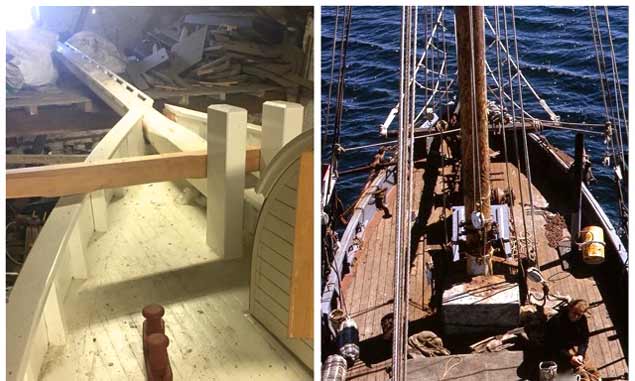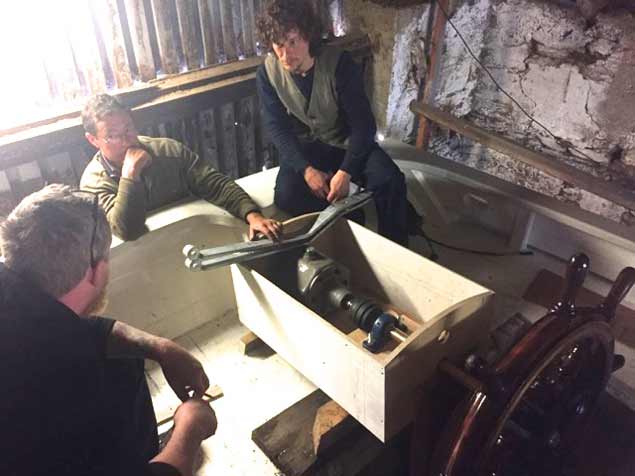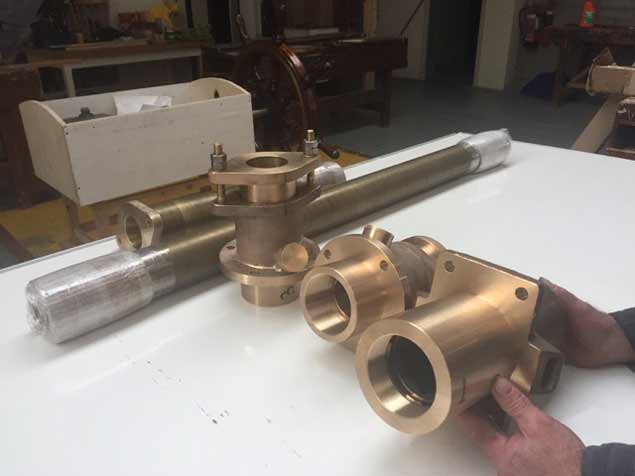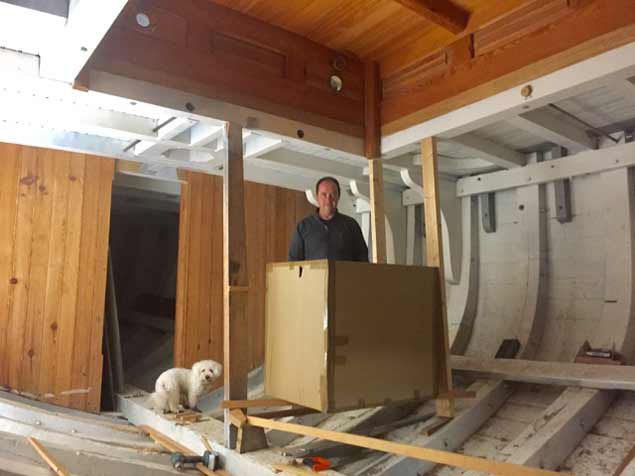With the hull of the 56ft 1926-built ketch Ilen fully restored in Oldcourt near Baltimore, attention has been turning to detailed items of equipment such as the steering system and the stern gear writes W M Nixon. And the “offering up” of the athwartships cathead, which will support the net under the mighty bowsprit as well as other more traditional functions such as lifting the anchor, has continued the migration of shaped wooden parts from the Ilen Boatbuilding School in Limerick to Liam Hegarty and his shipwrights with the hull in West Cork.
 Ilen’s new cathead (left), and the original one (right) from 1926. The simplification of the design to make do with one spar, instead of the traditional two at an angle, might have been Conor O’Brien’s own idea. Photo (left) Gary MacMahon
Ilen’s new cathead (left), and the original one (right) from 1926. The simplification of the design to make do with one spar, instead of the traditional two at an angle, might have been Conor O’Brien’s own idea. Photo (left) Gary MacMahon
 The new cathead is athwartships, forward of the jaunty little foredeck hatch which originally provided access to the cramped crew accommodation in the eyes of the ship. Photo Gary MacMahon
The new cathead is athwartships, forward of the jaunty little foredeck hatch which originally provided access to the cramped crew accommodation in the eyes of the ship. Photo Gary MacMahon
As the historic photo taken from aloft of Ilen’s foredeck in her original form shows, the simplified cathead was one athwartships spar, whereas in larger vessels it could be two spars, one each side, and angled at about 45 degrees to the fore-and-aft line. In Ilen’s case, it was long enough to help in the business of keeping the bowsprit in place, while maximizing the amount of clear space on the foredeck and over the rail.
Overall, attention is now also well focused on working out a friendly layout in the capacious accommodation. Originally, in her days as the freight vessel in the Falkland Islands, the best part of Ilen’s roomy hull amidships was taken up with the cargo hold. The crew quarters were cramped places, either right forward, or crowded in down aft at the little deckhouse.
 The steering system is introduced to the ship for the first time. Photo Gary MacMahon
The steering system is introduced to the ship for the first time. Photo Gary MacMahon
 All the hull fittings are in the best marine bronze. Photo: Gary MacMahon
All the hull fittings are in the best marine bronze. Photo: Gary MacMahon
But with the restoration, the deckhouse is enhanced, and though a classic hatchway has been installed right forward, the team have to take decisions on how best to lay out the amidships below-deck area for a vessel which will have to fill several roles
When fully commissioned again, Ilen will be based in Limerick with her programme built around the Shannon Estuary and further afield. But the plan is to have only seven sleeping bunks rather than the twelve which might be possible if she were going to be used only as a sail training vessel.
While the Ilen project may be all about the restoration of a very traditional vessel, doubtless a non-traditional computer will be used to envisage the best possible use of all that lovely space below. And even when CAD facilities have been utilised, the best plan is to make a mock-up before finalising the details, for even the smallest modification of one part of the layout affects the way that everything else falls into place in a three-dimensional jigsaw puzzle.
It’s worth persevering, for a traditionally-styled yet ergonomically friendly and welcoming layout below would make Ilen the little ship that everyone wants to be aboard.
 An interesting amount of space to be filled. James Madigan of the Ilen Boatbuilding School in Limerick down at Oldcourt in what used to be Ilen’s cargo hold, while behind him is the massive strengthening in the way of the mainmast. And on the left is ship’s dog Luna…… Photo: Gary MacMahon
An interesting amount of space to be filled. James Madigan of the Ilen Boatbuilding School in Limerick down at Oldcourt in what used to be Ilen’s cargo hold, while behind him is the massive strengthening in the way of the mainmast. And on the left is ship’s dog Luna…… Photo: Gary MacMahon


























































